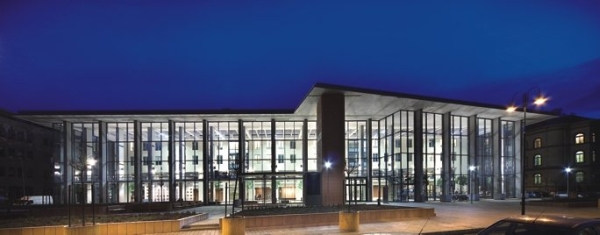From the Background into the Foreground
The Theoretical Medical Centre of Semmelweis University
Budapest Architectural Prize
Architects: Tamás Noll, Attila Madzin
Text: Péter Haba
Photo: Tamás Bujnovszky

The public investment worth 7,3 billion HUFs, which is an imposing one in Hungary even though a PPP (Public-Private Partnership) construction, was completed only a few months ago in Józsefváros. The building referred to has been one the General Medical Faculty of Semmelweis University had dreamt of for 60 years – this is for how long the work of five institutes has been going on specializing in indispensible research and education in an environment unfitted for this purpose. Tamás Noll, Attila Madzin, Rózsa Csavarga and their colleagues designed a building of excelling standards. Designers did not force the reconstruction of traditional urban block structure: instead they set the aim to create a compact mass form which improves the situation spontaneously formed, making more utilizable what is given and conjuring the spatial proportions of the streets more harmonious, whilst it still evokes something of the architectural-civic design characteristics of the area concerned.
Despite the wide variety of functions and the complex situation of development designers managed to have an extraordinarily clear and rational system of horizontal design derived directly from the function. The most self-evident possible and also the most fortunate solution has been selected. The overall impression is deviceless and yet professional: the architects’ ambition here is not represented by formal bravura, but by the creation of an unbroken and compact structure seemingly contradicting the facilities, an approach opening up the functional problems including the most delicate details, and the sensitivity to the urban medium receiving the building.

The longitudinal space of the aula is enriched by two rows of pillars flanking it – the one on the side of the glass partition rising as high as the ceiling, whilst the other one borders the communication area embracing the entire structure like a backbone. The more spacious auditoriums and the central corridors of the lateral wings running diagonally including the smaller rooms of the research institutes (laboratories, research rooms, services) open from the latter, just like the lift and the stairs leading upstairs. This main corridor has its equivalent on the first floor opening up toward the aula like a choir. The upper levels are more closed in character, with rooms opening in a row from the narrower central corridors (rooms with administrative and educational functions are in the longitudinal parts, whilst those serving research work are housed in the diagonal wings). Designers had a firm concept of the spatial process to serve the function as much as possible: from the street we step into the spacious public space, the aula, from where we can go on into the semi-public zone of the corridor with a row of pillars, and then into the closed areas. This kind of a disciplined, distinguishing designers’ attitude is evident in the shaping of forms as well as in the details and the selection of materials used. With its broken facade, row of slender pillars, transparent-glistening glass partitions, projecting roof plates the aula is a free-form, varied and open structure compared with the adjoining unit of educators and researchers forming a closed mass of a single prism. The terraced and stepped courtiles between the cross-wings are separated with glass partitions so as to make an unbroken prism form highlighting the contrast with the opened and unfolded transparent world of the aula. This hall is an excellent example of creating a representative imposing and generous space without complex and virtuosic forms based on the structure derived from the architectural system.
The world of interior spaces is rendered deliberately richer in ideas and more true-life than the exterior which refers to the function primarily by its laconicism. As for forms, it is a little more taut and strict, but never dry: it is counterbalanced by the areas where the brokenline of the glass facade is marked by a free-standing thicker pillar and a roof with acute-angled projection separating the foreground for the main entrance. This is where the worlds of the exterior and interior so different come to meet. The building seemingly homogeneous from every aspect concentrates several formal-attitudinal principles elevating it into a synthesis.
General design: Tamás Noll – M-Teampannon Kft.
Architect: Attila Madzin – M-Teampannon Kft.
Interior design: Rózsa Csavarga – M-Teampannon Kft.
Fellow architects: Pál László Alasztics, Eszter Ilka Cservenyák, Ágnes Klie, Ágnes Légár, Ildikó Pém, Gergely Sándor, Zsófia Szűcs, Krisztián Tóth, Bence Varga, Gábor Zahorán – M-Teampannon Kft.
Structure: István Kenese, Gabriella Berki – Megalit Kft.
Plumbing & HVAC: Gábor Cservenyák, Eliza Cservenyák, Béla Timkó, Áron Haász, István Bodnár, Miklós Ábel – Klimasoil Kft.
Electrical engineering: Mihály Kucskár – VIL-ART Kft.
Informatical network: Gábor Kiss – EL-IN TERV Kft.
Traffic: Miklós Szálka – Pro Urbe Kft.
Automation of the building: László Harmath – IQ Kft.
Acoustics: Gusztáv Józsa – Józsa és Társa 2000 Kft.
Fire protection: Levente Szöllősy – Tűzinfo.hu Bt.
Flooring: Antal Örkényi
Garden: Gabi Vastagh, Borbála Bárány – Garten Studio
Client: SE Campus Kft.
Main contractor: Arcadom Zrt.







